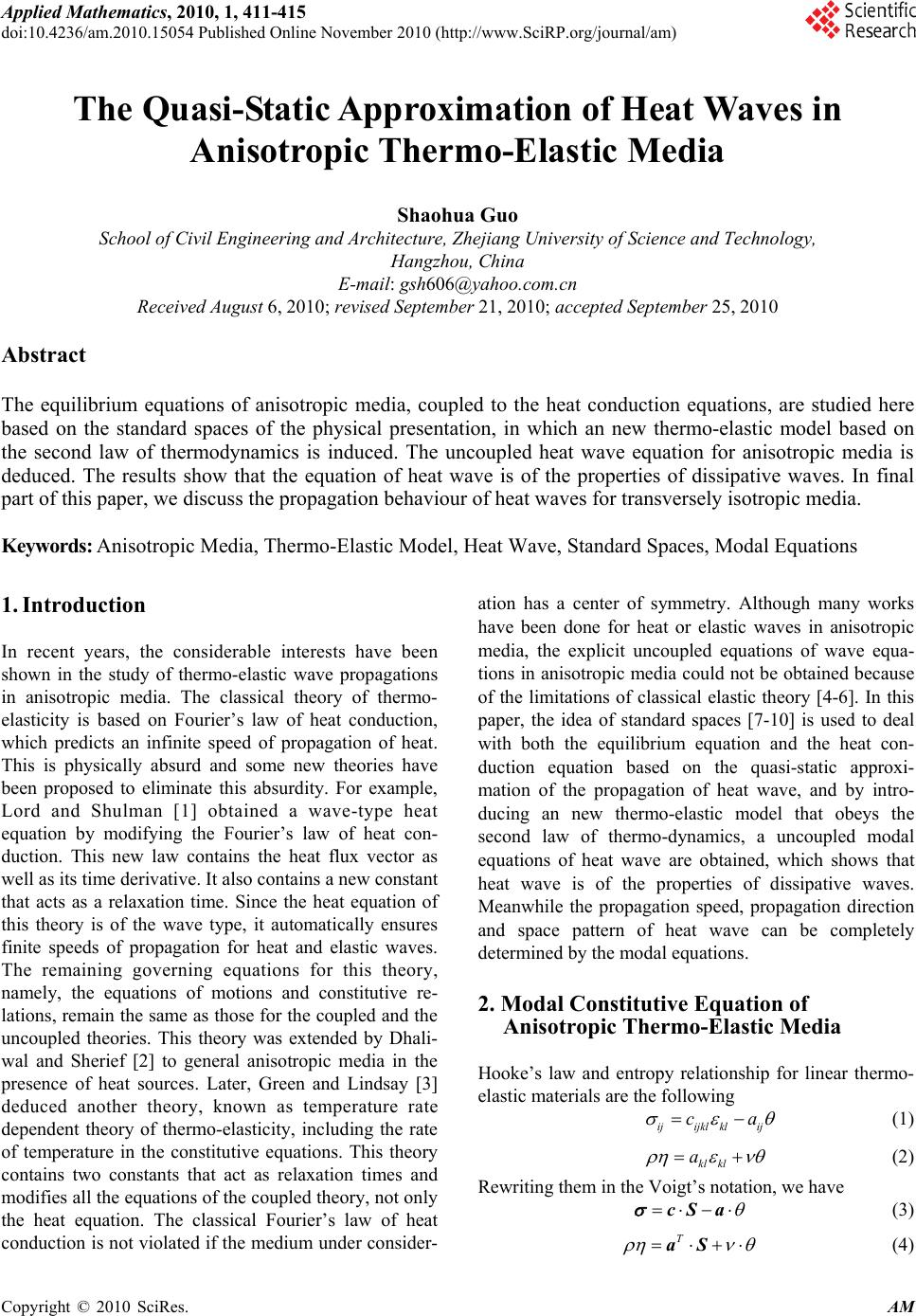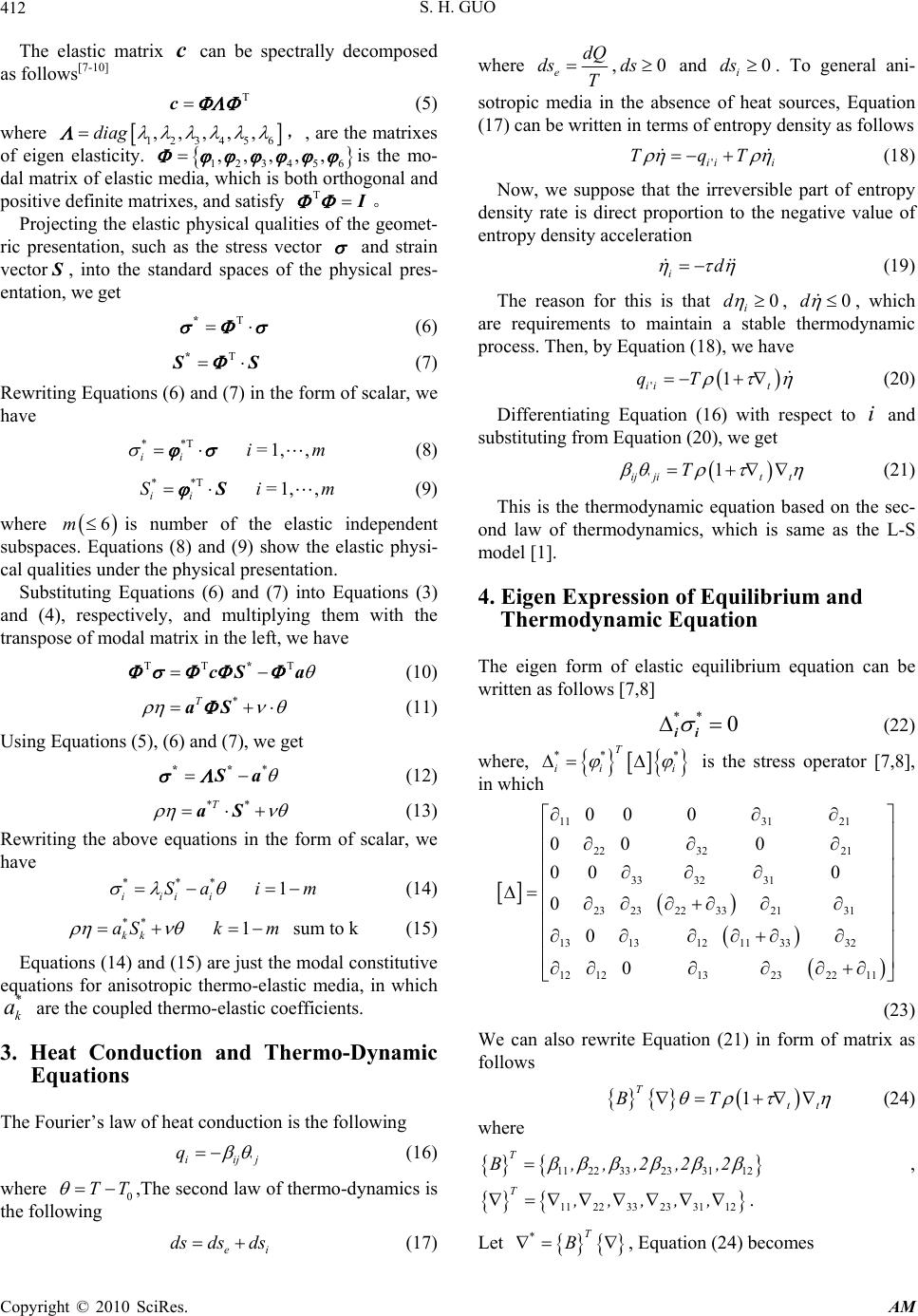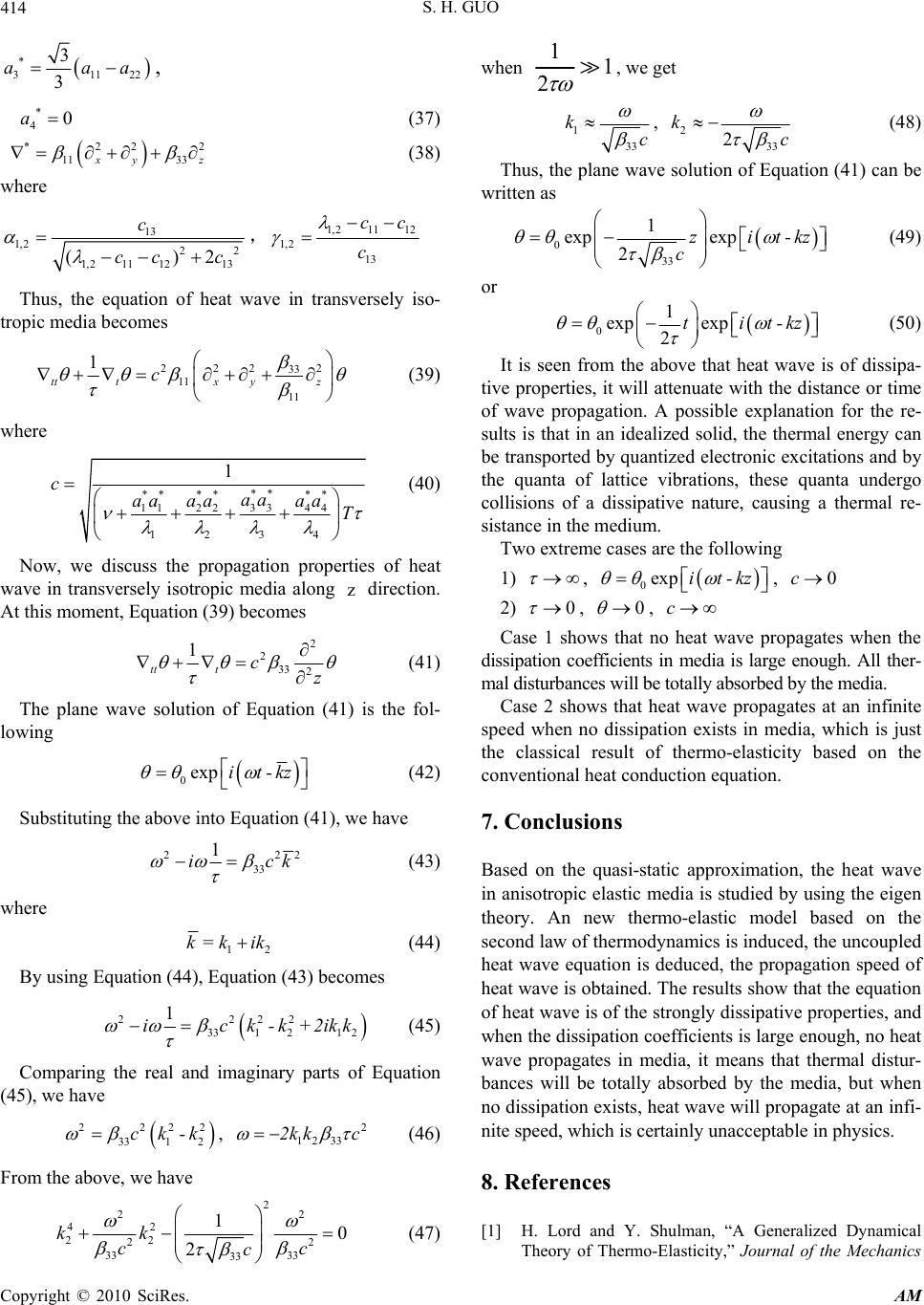Paper Menu >>
Journal Menu >>
 Applied Mathematics, 2010, 1, 411-415 doi:10.4236/am.2010.15054 Published Online November 2010 (http://www.SciRP.org/journal/am) Copyright © 2010 SciRes. AM The Quasi-Static Approximation of Heat Waves in Anisotropic Thermo-Elastic Media Shaohua Guo School of Civil Engineering and Architecture, Zhejiang University of Science and Technology, Hangzhou, China E-mail: gsh606@yahoo.com.cn Received August 6, 2010; revised September 21, 2010; accepted September 25, 2010 Abstract The equilibrium equations of anisotropic media, coupled to the heat conduction equations, are studied here based on the standard spaces of the physical presentation, in which an new thermo-elastic model based on the second law of thermodynamics is induced. The uncoupled heat wave equation for anisotropic media is deduced. The results show that the equation of heat wave is of the properties of dissipative waves. In final part of this paper, we discuss the propagation behaviour of heat waves for transversely isotropic media. Keywords: Anisotropic Media, Thermo-Elastic Model, Heat Wave, Standard Spaces, Modal Equations 1. Introduction In recent years, the considerable interests have been shown in the study of thermo-elastic wave propagations in anisotropic media. The classical theory of thermo- elasticity is based on Fourier’s law of heat conduction, which predicts an infinite speed of propagation of heat. This is physically absurd and some new theories have been proposed to eliminate this absurdity. For example, Lord and Shulman [1] obtained a wave-type heat equation by modifying the Fourier’s law of heat con- duction. This new law contains the heat flux vector as well as its time derivative. It also contains a new constant that acts as a relaxation time. Since the heat equation of this theory is of the wave type, it automatically ensures finite speeds of propagation for heat and elastic waves. The remaining governing equations for this theory, namely, the equations of motions and constitutive re- lations, remain the same as those for the coupled and the uncoupled theories. This theory was extended by Dhali- wal and Sherief [2] to general anisotropic media in the presence of heat sources. Later, Green and Lindsay [3] deduced another theory, known as temperature rate dependent theory of thermo-elasticity, including the rate of temperature in the constitutive equations. This theory contains two constants that act as relaxation times and modifies all the equations of the coupled theory, not only the heat equation. The classical Fourier’s law of heat conduction is not violated if the medium under consider- ation has a center of symmetry. Although many works have been done for heat or elastic waves in anisotropic media, the explicit uncoupled equations of wave equa- tions in anisotropic media could not be obtained because of the limitations of classical elastic theory [4-6]. In this paper, the idea of standard spaces [7-10] is used to deal with both the equilibrium equation and the heat con- duction equation based on the quasi-static approxi- mation of the propagation of heat wave, and by intro- ducing an new thermo-elastic model that obeys the second law of thermo-dynamics, a uncoupled modal equations of heat wave are obtained, which shows that heat wave is of the properties of dissipative waves. Meanwhile the propagation speed, propagation direction and space pattern of heat wave can be completely determined by the modal equations. 2. Modal Constitutive Equation of Anisotropic Thermo-Elastic Media Hooke’s law and entropy relationship for linear thermo- elastic materials are the following ijijkl klij ca (1) kl kl a (2) Rewriting them in the Voigt’s notation, we have cS a (3) T aS (4)  S. H. GUO Copyright © 2010 SciRes. AM 412 The elastic matrix c can be spectrally decomposed as follows[7-10] c (5) where 123456 ,,,,,diag ,, are the matrixes of eigen elasticity. 123456 ,,,,, is the mo- dal matrix of elastic media, which is both orthogonal and positive definite matrixes, and satisfy TI 。 Projecting the elastic physical qualities of the geomet- ric presentation, such as the stress vector and strain vector S , into the standard spaces of the physical pres- entation, we get * (6) * S S (7) Rewriting Equations (6) and (7) in the form of scalar, we have ** 1, , ii i= m (8) ** 1, , ii Si=m S (9) where 6mis number of the elastic independent subspaces. Equations (8) and (9) show the elastic physi- cal qualities under the physical presentation. Substituting Equations (6) and (7) into Equations (3) and (4), respectively, and multiplying them with the transpose of modal matrix in the left, we have * cS a (10) *T aS (11) Using Equations (5), (6) and (7), we get * ** S a (12) **T aS (13) Rewriting the above equations in the form of scalar, we have *** 1 iiii Sai m (14) ** 1 kk aSk m sum to k (15) Equations (14) and (15) are just the modal constitutive equations for anisotropic thermo-elastic media, in which * k a are the coupled thermo-elastic coefficients. 3. Heat Conduction and Thermo-Dynamic Equations The Fourier’s law of heat conduction is the following 'iijj q (16) where 0 TT ,The second law of thermo-dynamics is the following ei ds dsds (17) where e dQ ds T ,0ds and 0 i ds . To general ani- sotropic media in the absence of heat sources, Equation (17) can be written in terms of entropy density as follows 'ii i TqT (18) Now, we suppose that the irreversible part of entropy density rate is direct proportion to the negative value of entropy density acceleration id (19) The reason for this is that 0 i d , 0d , which are requirements to maintain a stable thermodynamic process. Then, by Equation (18), we have '1 ii t qT (20) Differentiating Equation (16) with respect to i and substituting from Equation (20), we get '1 ij jitt T (21) This is the thermodynamic equation based on the sec- ond law of thermodynamics, which is same as the L-S model [1]. 4. Eigen Expression of Equilibrium and Thermodynamic Equation The eigen form of elastic equilibrium equation can be written as follows [7,8] ** 0 ii (22) where, ** * T ii i is the stress operator [7,8], in which 1131 21 22 3221 33 3231 23 2322332131 131312113332 12 1213232211 00 0 00 0 00 0 0 0 0 (23) We can also rewrite Equation (21) in form of matrix as follows 1 T tt BT (24) where 11 22 33233112 T B,,,2,2,2 , 1122 33 23 3112 T,,,,, . Let *T B , Equation (24) becomes  S. H. GUO Copyright © 2010 SciRes. AM 413 *1tt T (25) 5. Modal Equation of Heat Wave in Anisotropic Media Substituting Equations (14,15) into Equations (22) and (25), we have ***0 iiii Sa (26) *** 1ttkk TaS (27) According to the principle of operator, Equation (26) can be written as follows * *k k k a S (28) By using Equation (28), Equation (27) becomes ** ** *0 kk kk ttt kk kk aa aa TT (29) Rewriting Equation (29) in the form of wave equation, we get 2* 1 ttt c (30) where ** 1 kk kk caa T (31) It just the speed of heat wave in anisotropic media. 6. Application In this section, we discuss the propagation laws of heat wave in a hexagonal (transversely isotropic) crystal. The material tensors in Equations (1), (2), (16) are represented by the bottom matrices (32) under the compact notation where 6611 12 1 2 ccc . There are four independent eigenspaces in a hexagonal (transversely isotropic) crystal [7-10] (1) (1)(2)(2) 1122336445 [][ ][,][, ]WWWWW φ (33) where as shown in Equation (34) where i ξ is a vector of order 6 in which ith element is 1 and others are 0. The eigenelasticity of hexagonal crystal are 2 2 11 1233111233 1,2 13 311124 44 2, 22 , ccc cccc cc c (35) The structures of four independent eigen-spaces are the following * 1, 21, 2 φ φ , * 3 31,1,0, 0, 0,1 3 T φ, * 4 20, 0, 0,1,1,0 2 T φ (36) * 1 ,21,211221, 233 []aaaa , The relative quantities and operators can be calculated as follows: 11 1213 121113 11 11 13 1313 11 11 44 33 33 44 66 000 000 000 ,, 00000 00 0 00000 ccc ccc a ccc a ca c c (32) T 1,2 11 12 13 1,2 22 3 1,2 11 1213 T 3 1,1,, 0, 0, 0 ()2 21,1, 0, 0, 0, 0 2 ,4,5,6 ii cc c c ccc i (34)  S. H. GUO Copyright © 2010 SciRes. AM 414 * 31122 3 3 aaa, * 40a (37) *222 11 33 x yz (38) where 13 1,2 22 1,211 1213 ()2 c cc c ,1,211 12 1, 2 13 cc c Thus, the equation of heat wave in transversely iso- tropic media becomes 2222 33 11 11 1 tttx yz c (39) where ** ** **** 33 11 2244 1234 1 caa aaaaaaT (40) Now, we discuss the propagation properties of heat wave in transversely isotropic media along z direction. At this moment, Equation (39) becomes 2 2 33 2 1 ttt cz (41) The plane wave solution of Equation (41) is the fol- lowing 0exp it-kz (42) Substituting the above into Equation (41), we have 222 33 1 ick (43) where 12 k=k ik (44) By using Equation (44), Equation (43) becomes 2222 33121 2 1 ick-k+2ikk (45) Comparing the real and imaginary parts of Equation (45), we have 2222 331 2 ck-k , 2 12 33 2k kc (46) From the above, we have 2 22 42 22 22 33 33 33 10 2 kk cc c (47) when 11 2 , we get 1 33 kc , 2 33 2 kc (48) Thus, the plane wave solution of Equation (41) can be written as 0 33 1 exp exp 2zit-kz c (49) or 0 1 exp exp 2tit-kz (50) It is seen from the above that heat wave is of dissipa- tive properties, it will attenuate with the distance or time of wave propagation. A possible explanation for the re- sults is that in an idealized solid, the thermal energy can be transported by quantized electronic excitations and by the quanta of lattice vibrations, these quanta undergo collisions of a dissipative nature, causing a thermal re- sistance in the medium. Two extreme cases are the following 1) , 0exp it-kz , 0c 2) 0 , 0 , c Case 1 shows that no heat wave propagates when the dissipation coefficients in media is large enough. All ther- mal disturbances will be totally absorbed by the media. Case 2 shows that heat wave propagates at an infinite speed when no dissipation exists in media, which is just the classical result of thermo-elasticity based on the conventional heat conduction equation. 7. Conclusions Based on the quasi-static approximation, the heat wave in anisotropic elastic media is studied by using the eigen theory. An new thermo-elastic model based on the second law of thermodynamics is induced, the uncoupled heat wave equation is deduced, the propagation speed of heat wave is obtained. The results show that the equation of heat wave is of the strongly dissipative properties, and when the dissipation coefficients is large enough, no heat wave propagates in media, it means that thermal distur- bances will be totally absorbed by the media, but when no dissipation exists, heat wave will propagate at an infi- nite speed, which is certainly unacceptable in physics. 8. References [1] H. Lord and Y. Shulman, “A Generalized Dynamical Theory of Thermo-Elasticity,” Journal of the Mechanics  S. H. GUO Copyright © 2010 SciRes. AM 415 and Physics, Vol. 15, No. 5, 1967, pp. 299-309. [2] R. Dhaliwal and H. Sherief, “Generalized Thermoe- lasticity for Anisotropic Media,” The Quarterly of Appli- ed Mathematics, Vol. 33, Vol. 1, 1980, pp. 1-8. [3] A. E. Green and K. E. Lindsay, “Thermoelasticity,” Journal of Elasticity, Vol. 2, 1972, pp. 1-7. [4] X. G. Tian, Y. P. Shen, et al., “A Direct Finite Element Method Study of Generalized Thermoelastic Problems,” International Journal of Solids and Structures, Vol. 43, No. 7-8, 2006, pp. 2050-2063. [5] T. C. Chen and C. I. Weng, “Generalized Coupled Transient Thermoelastic Plane Problems by Laplace Transform/Finite Element Method,” Journal of Applied Mechanics, Vol. 55, No. 2, 1988, pp. 377-382. [6] J. H. Prevost and D. Tao, “Finite Element Analysis of Dynamic Coupled Thermoelasticity Problems with Rela- xation Times,” Journal of the Mechanics and Physics, Vol. 50, 1983, pp. 817-822. [7] S. H. Guo, “An Eigen Theory of Rheology for Complex Media,” Acta Mechanica, Vol. 182, 2007, pp. 985-992. [8] S. H. Guo, “An Eigen Theory of Electromagnetic Waves Based on the Standard Spaces,” International Journal of Engineering Science, Vol. 47, 2009, pp. 405-412. [9] S. H. Guo, “An Eigen Theory of Waves in Piezoelectric Solids,” Acta Mechanica Sinica, Vol. 26, No. 2, 2010, pp. 241-246. [10] S. H. Guo, “An Eigen Theory of Electro-Magnetic Acoustic Waves in Magnetoelectroelastic Media,” Acta Mechanica, Vol. 211, No. 1-2, 2010, pp. 173-180. |

